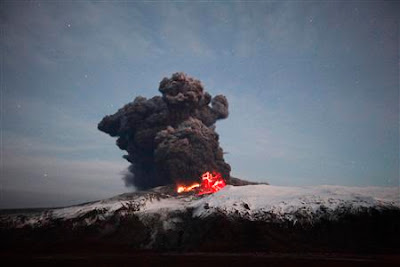
By Omar Valdimarsson
REYKJAVIK (Reuters) - Powerful tremors from an Icelandic volcano that has been a menace for travelers across Europe shook the countryside on Sunday as eruptions hurled a steady stream of ash into the sky.
Ash from the volcano drifted southeast toward the European continent, sparing the capital Reykjavik and other more populated centres but forcing farmers and their livestock indoors as a blanket of ash fell on the surrounding areas.
"We are all doing our utmost to make sure that the farming community in this area survives this disaster," Icelandic President Olafur Grimsson told Reuters Television.
He said it was difficult to assess the impact on tourism in the country, which is only just emerging from a deep recession, but that recent events had put Iceland in the spotlight and that the country might even lure in more visitors.
"What we are experiencing here in Iceland is forces of nature on display... And that is a spectacle -- the combination of volcanic eruption and glaciers you cannot see anywhere else in the world," he said.
Iceland's Meterological Office said tremors from the volcano had grown more intense but that the column of ash rising from the volcano had eased back to 4-5 km (2.5-3 miles) from as high as 11 km when it started erupting earlier this week.
"We are seeing mixed signals. There are some hints that the eruption will be decreasing, and others that show it is not decreasing," said Einar Kjartansson, a geophysicist at the Meteorological Office.
The eruption is taking place under Iceland's Eyjafjallajokull glacier, normally a popular hiking ground about 120 km (75 miles) southeast of the capital Reykjavik.
Kjartansson believes the volcano has melted about 10 percent of the glacier, but melting might have slowed in recent hours.
However, that does not mean Europe will see any great relief from the plume of ash that is choking the upper atmosphere with tiny particles of glass and pulverized rock, threatening jet engines and airframes.
The glacier on top of the volcano is about 200 meters (650 ft) thick -- thinner than many glaciers atop other volcanoes that have erupted in recent times. That means there is less ice, and water, to suffocate the eruptions and resulting steam.
"It might mean more intense ash production," Kjartansson said.
It still could take months for the volcano to burn through the rest of the glacier, to a point where the steam and ash would turn instead into lava, he said.
DAY TURNS TO NIGHT Vidir Reynisson, of the Civil Protection Department, said some areas near the volcano were pitchblack during daylight hours.
"There are places where you can't even see the palm of your hand," he said.
Many farmers remained to tend their livestock and some, assisted by rescue squads, were on rooftops sweeping off the accumulated ash to prevent roofs from caving in. There were no disruptions to electricity or water supplies in the area.
Meanwhile, travelers stranded in Iceland due to limited flights out of the international Keflavik airport got approval on travel to Norway.
Icelandair said it was running five flights to Trondheim in Norway with a total of 800 passengers while Iceland Express flew once. Flights to and from the United States remained unaffected.
But more delays and diversions could be in store for Europe.
U.S.-based forecaster AccuWeather said winds at the level of the ash plume were expected to continue steering it from Iceland into northern Britain and southern Scandinavia through Monday.
The winds are seen shifting farther south Tuesday and Wednesday, sending any ash farther south and putting Germany and the Netherlands at greater risk, it said.
Iceland sits on a volcanic hotspot in the Mid-Atlantic Ridge and has relatively frequent eruptions, though most occur in sparsely populated areas and pose little danger to people or property. The last eruption took place in 2004.
(Writing and additional reporting by Mia Shanley in Stockholm, editing by Dominic Evans)
http://www.scientificamerican.com/article.cfm?id=volcanic-ash-relentless

Tidak ada komentar:
Posting Komentar